- Bernard Preston homepage
- Yellows
- Beta-carotene Is Also Called Vitamin A
Beta-carotene is also called vitamin A
Beta-carotene is also called vitamin A; dozens of children die every single day in South Africa from a deficiency. Worldwide it runs in the thousands; daily. Many of them first turn blind.
Vitamins are complicated substances; most of them are actually families of nutrients, all important but found in many different foods. So one can seemingly be enjoying an adequate diet or taking supplements and yet still be deficient with devastating consequences; so is it with vitamin A.
The precursor of vitamin A from our food is beta-carotene which is first broken down in the gut to retinal, the aldehyde form.
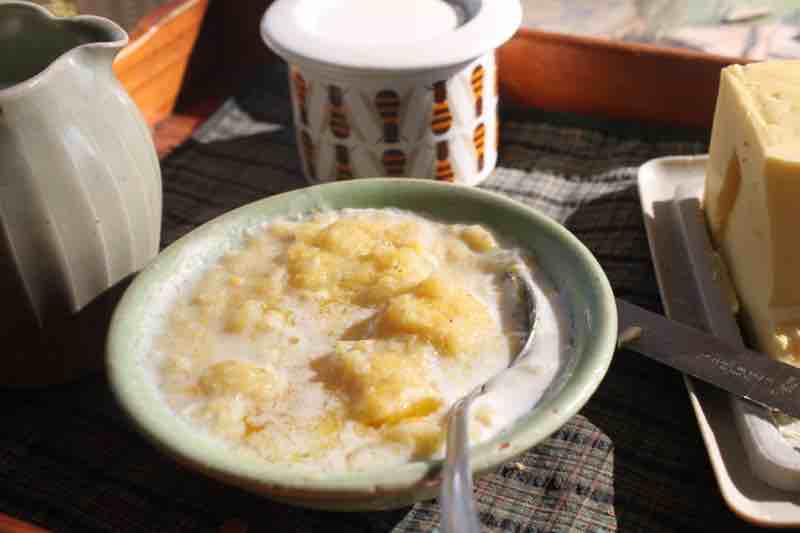 Yellow cornmeal with added butter for increased absorption of the beta-carotene.
Yellow cornmeal with added butter for increased absorption of the beta-carotene.Two main sources of vitamin A
- From "preformed" vitamin A
- From "provitamin A carotenoids"
Preformed vitamin A
Preformed vitamin A is a fat soluble compound found in many foods from animal sources; eggs, fish and dairy products for example.
The poor, unable to afford these more expensive foods and vegans would get no preformed vitamin A.
Omnivores would get plenty of preformed vitamin A of animal origin from their food; a deficiency would be rare.
Provitamin A carotenoids
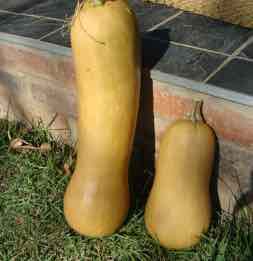 Butternut for beta-carotene
Butternut for beta-caroteneCertain nutritional compounds in fruits and vegetables known as carotenoids can be broken down in the gut and the liver to vitamin A.
Carrots are one obvious example. The orange colour in yellow corn and butternut also signals the presence of these compounds that are so beneficial to the human body. In fact we cannot live without vitamin A. Chaote squash is another rich source.
Vegans are likely to get plenty of provitamin A carotenoids from their food; more than sufficient. However the very poor who either cannot afford these fruits and vegetables or who through ignorance choose varieties that are low in them certainly suffer from a serious deficiency.
 Yellow maizemeal
Yellow maizemealThe orange varieties of corn are the only grain with significant amounts of provitamin A carotenoids.
For example in South Africa where mental and physical stunting affects nearly half the small children in rural areas, parents may choose white maizemeal as their staple food; it has very little provitamin A carotenoids.
Certain varieties of corn characterised by a deep orange colour have even more beta-carotene, the precursor of vitamin A.
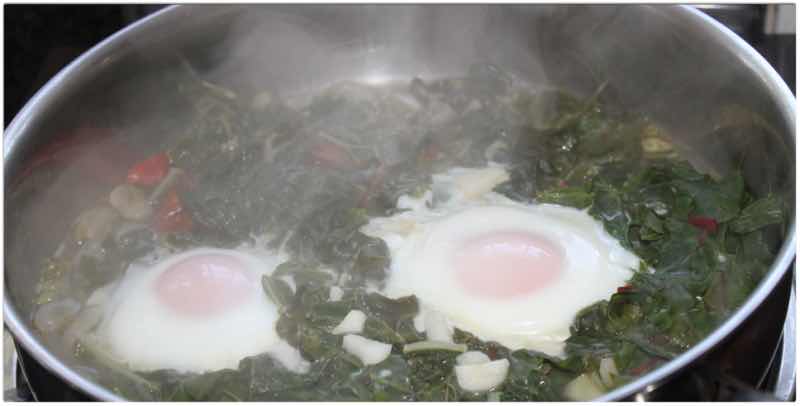 Both spinach and eggs are rich in beta-carotene, the precursor of vitamin A.
Both spinach and eggs are rich in beta-carotene, the precursor of vitamin A.Eggs Florentine is a dish rich in both preformed and provitamin A compounds.
Vitamin A from yellow maizemeal
Maize in Southern Africa is a staple food supplying more than two-thirds of the energy intake of the poor. An average person would consume between 300 to 400 grams per day. Fruit and vegetable consumption however is far below those amounts recommended by the WHO for provitamin A and other important nutrients.
Researchers in Zimbabwe found that 300mg of porridge made from yellow maizemeal provided 0.38 mg of retinol, almost half of the RDA for an adult[1].
Chickens, pigs and cattle also need vitamin A; consequently most yellow maizemeal is directed to animal feed. Humans also prefer that from white varieties making them prone to a retinol deficiency.
Yellow maize is about 15% cheaper than white varieties. Zimbabwe has found that by lower pricing and public education campaigns this preference for low vitamin A cornmeal can be overcome.
However they found that yellow maize, perceived as animal feed is handled more poorly, particularly if imported, giving it a bad taste; consequently it was not consumed by a majority of Zimbabweans who also were not aware of its greater nutritional benefits.
Local production of yellow maize produced a superior product, better tolerated by vulnerable humans prone to a vitamin A deficiency[2].
Maizemeal
730 g
Porridge
2400 g
Serving
300 g
Roughly 5 cups of maizemeal is mixed with an equivalent amount of cold water and mixed into a thick paste with a wooden spoon.
15 cups of boiling water are added, perhaps a little more, 5 tsp of salt and the mixture vigorously stirred on high heat until the porridge starts to bubble. Scrape the bottom regularly so that it does not stick.
Cook on low heat for 40 minutes; better still overnight on a wood stove or in a hotbox. Texture improves if the bran is given more time to absorbe water.
This will make 8 servings of 300 grams of yellow maizemeal porridge, a rich source of beta-carotene that will provide almost 50% of the RDA for vitamin A.
It will also contain large amounts of lutein, zeaxanthin and beta-cryptoxanthin, other important carotenoids, proven to help prevent macular degeneration and dementia.
White maizemeal would provide none of this protection against serious disease. When refined nearly half of the protein and all of the bran and germ are also extracted; for animal feed.
Recommended Daily Allowance of vitamin A
The Recommended Dietary Allowance is 900 and 700 mcg for men and females respectively; it is measured in "Retinol Activity Equivalents" to allow for different rates of absorption from provitamin A carotenoids.
Alternatively it was previously measured in International Units (IUs).
Age
- To convert IU to mcg
- Small child
- 5y old
- 10y old
- Older than 14
IU
- 100IU
- 1000
- 1333
- 2000
- 2333
- 3000
RAE (mcg)
- 30 mcg
- 300
- 400
- 600
- 700 female
- 900 male
Vitamin A and the eyes
I think most of us know there is an association between carrots and night blindness; it is not an old wives' tale. Rhodopsin is the light-sensitive protein in the rod photoreceptors in the eye; vitamin A is an essential component.
The compound consists of a molecule of retinal joined to an opsin protein.
B-carotene is cleaved by enzymes in the lining of the wall of the gut into two retinal molecules; they can then join onto the opsin protein in the retina of the eye enabling us to detect incoming light.
If you are interested in the biochemistry behind vitamin A and its many other forms, the NIH has an excellent fact sheet[3].
Vitamin A and the immune system
Vitamin A plays a very important role in the epithelial cells lining the gut where it attaches to a specific receptor that generates the immune response to invading pathogens.
A deficiency of beta-carotene, also called vitamin A makes children vulnerable to diarrhoeal infections of the gut, other viral conditions and especially measles.
SUMMARY
- 100 million children in sub-Saharan Africa have a subclinical vitamin A deficiency[4].
- 1 million of these children die every year, many from measles.
- Half a million of them will go blind.
Risk factors for a vitamin A deficiency
- Education departments of governments that promote the consumption of white maize rather than the yellow varieties for children.
- Departments of Health that fail to understand the importance and power of public education programmes that promote vitamin A rich foods including yellow maizemeal.
- Poverty, ignorance and malnutrition.
- Millers that extract the bran, germ and the fats that contribute to the absorption of the carotenes, profiteering rather from selling them as animal feed.
In short a deficiency should be relatively rare. Chaote squash, butternut and yellow maize are not difficult to grow; beta-carotene is also called vitamin A.
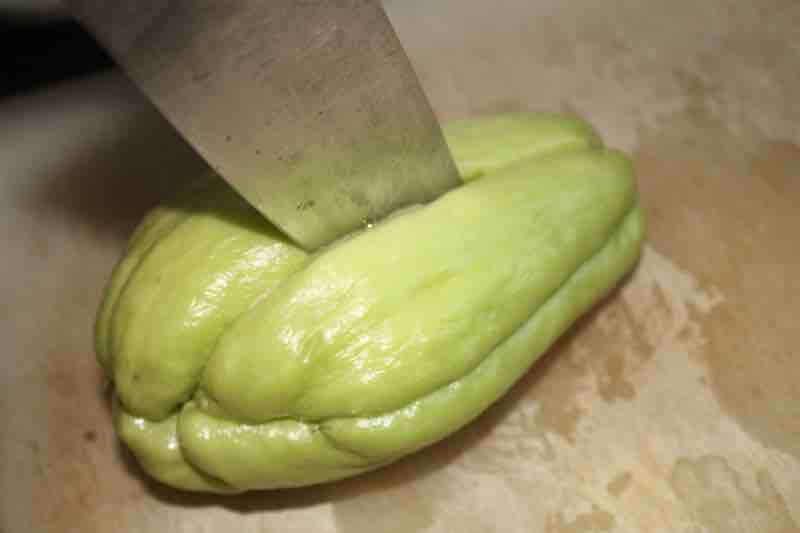 Chaote squash is rich in carotenoids
Chaote squash is rich in carotenoidsSuper-refined white maize should attract a sin tax, just like sugar. Daily consumption of cheaper, wholegrain yellow cornmeal would virtually wipe out the vitamin A deficiency that kills so many children; and causes half a million kids to become blind.
Beta-carotene is also called vitamin A; it's the precursor.
Beta-carotene is also called vitamin A
Beta-carotene is also called vitamin A; it's an important precursor.
Unrefined yellow maizemeal is also a rich source of another of the important fat-soluble compounds known as alpha tocopherol; it's the body's anticoagulant called vitamin E. There is also some of the gamma isomer that gives protection against prostate cancer.
Serious clot-related diseases such as heart attacks and stroke have soared since the refining of grains, extracting the fat soluble vitamins.
Enrich your yellow grits with greens
There is an age-old tradition amongst the Xhosa people in South Africa to enrich yellow grits with greens and other vegetables; that gives a double boost of the beta-carotene that is also called vitamin A. Typically it would include onion, spinach and unrefined maizemeal; all three are rich sources preventing the serious deficiency that causes so many deaths.
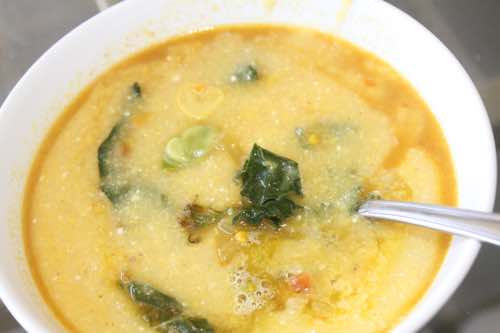
Children who are given unrefined yellow maizemeal porridge enriched with onion, spinach and beans have a great start in life; it's high in protein and the beta-carotene called vitamin A.
The taste too greatly enhanced; butter or cream would increase the absorption of the fat-soluble vitamins.
When browsing use right click and "Open Link in New Tab" or you may get a bad gateway signal.
Newsletter
Our newsletter is entitled "create a cyan zone" at your home, preserving both yourself and Mother Earth for future generations; and the family too, of course. We promise not to spam you with daily emails promoting various products. You may get an occasional nudge to buy one of my books.
Here are the back issues.
- Lifestyle and ideal body weight
- What are ultra-processed foods?
- Investing in long-term health
- Diseases from plastic exposure
- Intensive lifestyle management for obesity has limited value
- A world largely devoid of Parkinson's Disease
- The impact of friendly bacteria in the tum on the prevention of cancer
- There's a hole in the bucket
- Everyone is talking about weight loss drugs
- Pull the sweet tooth
- If you suffer from heartburn plant a susu
- Refined maize meal and stunting
- Should agriculture and industry get priority for water and electricity?
- Nature is calling
- Mill your own flour
- Bake your own sourdough bread
- Microplastics from our water
- Alternative types of water storage
- Wear your clothes out
- Comfort foods
- Create a bee-friendly environment
- Go to bed slightly hungry
- Keep bees
- Blue zone folk are religious
- Reduce plastic waste
- Family is important
- What can go in compost?
- Grow broad beans for longevity
- Harvest and store sunshine
- Blue zone exercise
- Harvest and store your rainwater
- Create a cyan zone at your home
Did you find this page interesting? How about forwarding it to a friendly book or food junkie? Better still, a social media tick would help.
- Bernard Preston homepage
- Yellows
- Beta-carotene Is Also Called Vitamin A
Address:
56 Groenekloof Rd,
Hilton, KZN
South Africa
Website:
https://www.bernard-preston.com